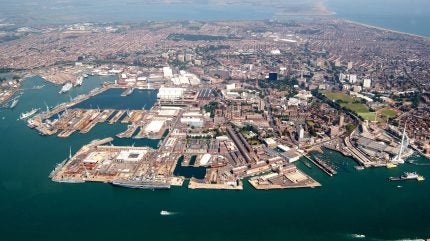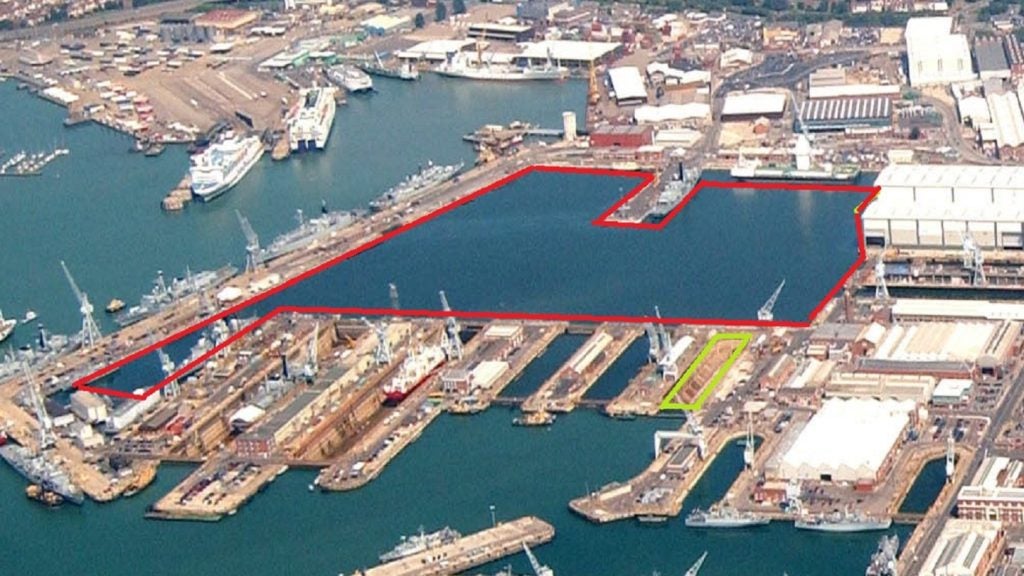
An “abnormal” amount of water leaking from 3 Basin inside the UK’s Portsmouth Naval Base will require a new water level management system – large pumps – to be installed in order to maintain the operational water levels of the site.
In a recent contract tender published by the UK Ministry of Defence (MoD), it was stated that 3 Basin at Portsmouth Naval Base, described as “essential infrastructure” to the base, was seeing “abnormal amounts of leakage through various points throughout its boundaries” and, as such, a system had to be installed in order to manage the levels.
The current system sees the opening up of 3 Basin to the harbour on sufficiently high tides, which was performed “at great expense in terms of labour”, as well as wear on existing “aged” infrastructure.
Due to the location of 3 Basin, and the tight confines inside Portsmouth Naval Base, any contractor selected to fulfill the tender “should be aware that the works detailed in this package are constrained due to the nature of the location they are to be conducted in”, the tender stated.
The planned solution will see a pumping system established at the head of neighbouring 9 Dock, which will draw tidal waters from there to discharge into 3 Basin. Due to the aforementioned confines of the site, any pipes or cables would need to be “ramped over” to enable traffic on the roadway running between 9 Dock and 3 Basin to flow.
The MoD tender stated that the total discharge capacity of the pumps shall be no less than 1800m3/hr and that any solution should also include a system to monitor water levels in 3 Basin and control the installed pumps accordingly.
How well do you really know your competitors?
Access the most comprehensive Company Profiles on the market, powered by GlobalData. Save hours of research. Gain competitive edge.

Thank you!
Your download email will arrive shortly
Not ready to buy yet? Download a free sample
We are confident about the unique quality of our Company Profiles. However, we want you to make the most beneficial decision for your business, so we offer a free sample that you can download by submitting the below form
By GlobalData
The value of the contract is minimal, around £200,000 ($253,000), and include a planned maintenance regime for at least one year after installation and a planned proposal for a further two years.
Portsmouth Naval Base is a key UK naval logistics hub and home to almost two-thirds of the Royal Navy’s surface fleet, including the flagship aircraft carriers HMS Queen Elizabeth and HMS Prince of Wales, the Type 45 air defence destroyers, Type 23 frigates, and elements of the mine countermeasure and fisheries protection squadrons.
Leaks not uncommon in UK’s historic naval infrastructure
Such rectification work on the UK’s naval infrastructure is not without precedent, with the leak rate at 3 Basin in Devonport Naval Base in 2023 deemed sufficient to require the award of a £3m contract to repair the site’s “access and egress point capability”, according to a contract announcement at the time.
The MoD stated at the time that work would allow “the safe and secure storage of Laid Up Submarines, future surface ships, and other strategic assets” for a minimum of 80 years. The deal was awarded to Preston-based engineering company Volkerstevin in January 2023 and has an expected end date of 31 August 2024.
Laid up in 3 Basin at HMNB Devonport is the legacy of the UK’s nuclear submarine capability, with 13 decommissioned Royal Navy nuclear-powered attack submarines inside its perimeter. Water level controls are typically used to manage the volume of water inside such sites, depending on leak rates.
Water egressing some naval locations used to store nuclear-powered vessels is routinely tested for contaminants, with the leak at Basin 3 located along the southern wall section.
The UK’s Submarine Dismantling Project
The repair work being undertaken to 3 Basin at HMNB Devonport is understood to not be a part of the ongoing Submarine Dismantling Project (SDP), a multi-year programme intended to scrap dozens of nuclear-powered submarines once in service with the Royal Navy (RN).
The majority of submarines stored at Rosyth, Scotland, and Devonport, England, are thought to have been defuelled since being decommissioned, although hazardous and classified materials remain onboard, requiring specific clearances and capabilities to be disposed of safely.
The SDP’s mandate is intended to fully dismantle 27 of the UK’s nuclear-powered submarines after they have been defuelled, including the ballistic missile boats (SSBN) that housed the country’s nuclear deterrent.
A new submarine defueling and dismantling facility built at Devonport is about to come online, enabling the safe disposal of powered down nuclear reactors.
In February 2022, the MoD revealed that HMS Valiant would be the first nuclear-powered submarine in Devonport to undergo dismantling. According to a 2019 investigation by the UK’s National Audit Office into submarine defuelling and dismantling, the MoD spent an estimated £500mn since 1980 on storing and maintaining its retired nuclear submarines.
The UK currently has five of a planned seven Astute-class SSNs in service or commissioned, these being HMS Astute, Ambush, Artful, Audacious, and Anson). The UK also operates a single remaining Trafalgar-class SSN, HMS Triumph.







